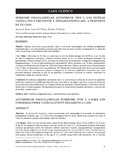| dc.rights.license | http://creativecommons.org/licenses/by-nc-sa/3.0/ve/ | es_VE |
| dc.contributor.author | Braca, Ayrton | |
| dc.contributor.author | Villena, Laura M. | |
| dc.contributor.author | El Kantar, Yusmary | |
| dc.date.accessioned | 2025-03-20T12:50:26Z | |
| dc.date.available | 2025-03-20T12:50:26Z | |
| dc.date.issued | 2025-03-20 | |
| dc.identifier.issn | 1690-3110 | |
| dc.identifier.uri | http://www.saber.ula.ve/handle/123456789/51483 | |
| dc.description.abstract | Objetivo: Exponer la frecuencia, presentación clínica y asociación inmunológica del síndrome poliglandular
autoinmune tipo 2, así como también la pesquisa que debe tener presente el médico al momento de la evaluación
clínica en pacientes con trastornos endocrinos múltiples.
Caso Clínico: Masculino de 46 años en control por el servicio Endocrinología del IAHULA; a los 10 años
de edad se diagnosticó micropene, volumen testicular menor de 4cc, se indicó tratamiento hormonal con
gonadotrofina coriónica humana (hCG), sin respuesta satisfactoria; posteriormente se diagnosticó hipogonadismo
hipogonadotrópico. Se asocia hipertiroidismo por enfermedad de Graves Basedow a los 26 años, manteniéndose
en terapia con antitiroideo por un lapso de 5 años hasta lograr eufunción. Debutó con insuficiencia adrenal primaria
a los 35 años, en tratamiento actual con prednisona. Es evaluado para tiroidectomía total electiva por bocio grado
3 eufuncionante. En ese momento se plantea el diagnóstico de síndrome poliglandular autoinmune tipo 2, por
presentar trastornos endocrinos en más de dos glándulas. Actualmente el paciente en estables condiciones en
seguimiento regular por consulta externa.
Conclusión: El síndrome poliglandular autoinmune tipo 2 se caracteriza por disfunción de más de dos glándulas
endocrinas, producto de la infiltración linfocítica que causa daño en un órgano específico, es poco frecuente que
los pacientes presenten disfunción de los 3 órganos endocrinos principales simultáneamente y suele haber una fase
latente entre las endocrinopatías. El tratamiento principal es la sustitución de hormonas deficientes y la prevención
de posibles complicaciones.
Recibido:noviembre 2024 - Aceptado: diciembre 2024 | es_VE |
| dc.language.iso | es | es_VE |
| dc.publisher | SaberULA | es_VE |
| dc.rights | info:eu-repo/semantics/openAccess | es_VE |
| dc.subject | Síndrome poliglandular tipo 2 | es_VE |
| dc.subject | Autoinmunidad | es_VE |
| dc.subject | Lesión glandular | es_VE |
| dc.title | Síndrome poliglandular autoinmune tipo 2, una entidad clínica poco frecuente e infradiagnosticada. A propósito de un caso | es_VE |
| dc.title.alternative | Autoinmune polyglandular syndrome type 2, a rare and underdiagnosed clinical entity. Regarding a case | es_VE |
| dc.type | info:eu-repo/semantics/article | es_VE |
| dcterms.dateAccepted | diciembre 2024 | |
| dcterms.dateSubmitted | noviembre 2024 | |
| dc.description.abstract1 | Objective: To present the frequency, clinical presentation and immunological association of autoimmune
polyglandular syndrome type 2, as well as the investigation that the doctor should keep in mind at the time of
clinical evaluation in patients with multiple endocrine disorders.
Case Report: Forty-six year old male under control by the Endocrinology Service of the IAHULA; at 10 years
of age he was diagnosed with micropenis, testicular volume less than 4 cc, and hormonal treatment with human
chorionic gonadotropin (hCG) was indicated, without satisfactory response; hypogonadotropic hypogonadism
was subsequently diagnosed. At 26 years of age, hyperthyroidism was associated due to Graves Basedow disease,
which was treated with antithyroid drugs for a period of 5 years until eufunction was achieved. He presented
with primary adrenal insufficiency at the age of 35, currently being treated with prednisone. He is currently
being evaluated for elective total thyroidectomy for grade 3 eufunctioning goiter. At this time, the diagnosis of
autoimmune polyglandular syndrome type 2 is proposed, due to presenting endocrine disorders in more than
two glands. Currently the patient is in stable condition and he is receiving regular follow-up through outpatient
consultation.
Conclusions: Autoinmune polyglandular syndrome type 2 is characterized by dysfunction of more than two
endocrine glands, as a result of lymphocytic infiltration that causes damage to a specific organ. It is rare for patients
to present dysfunction of the 3 main endocrine organs simultaneously and there is usually a latent phase among
endocrinopathies. The main treatment is the replacement of deficient hormones and the prevention of possible
complications. | es_VE |
| dc.description.colacion | 33-39 | es_VE |
| dc.description.email | rvdeme@gmail.com | es_VE |
| dc.description.email | ayrton.braca@gmail.com | es_VE |
| dc.description.frecuencia | Cuatrimestral | |
| dc.description.paginaweb | http://www.saber.ula.ve/rvem/ | |
| dc.identifier.depositolegal | ppi. 200902ME4351 | |
| dc.publisher.pais | Venezuela | es_VE |
| dc.subject.institucion | Universidad de Los Andes | es_VE |
| dc.subject.keywords | Polyglandular syndrome type 2 | es_VE |
| dc.subject.keywords | Autoimmunity | es_VE |
| dc.subject.keywords | Glandular injury | es_VE |
| dc.subject.seccion | Revista Venezolana de Endocrinología y Metabolismo: Caso clìnico | es_VE |
| dc.subject.tipo | Artículos | es_VE |
| dc.type.media | Texto | es_VE |


